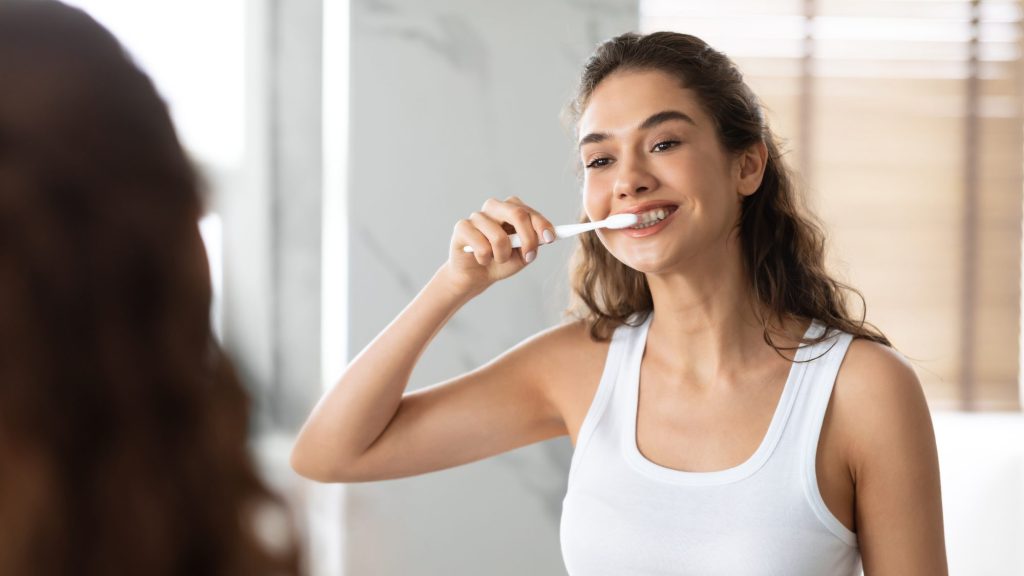Practicing good oral hygiene is essential to maintaining good oral health by preventing tooth decay and periodontal disease (gum disease) that can be caused by the bacteria that live on the surface of your teeth and in the sticky, white plaque that builds up on the teeth. These bacteria produce acids that break down tooth enamel, leading to decay. They can also infect the gum tissues, causing periodontal disease.
Brushing your teeth helps to remove the plaque and food particles from your teeth and gums. It also helps to prevent plaque from hardening into tartar which is more difficult to remove from the teeth and puts you at an increased risk of developing periodontal disease.
Additionally, brushing with toothpaste that contains fluoride helps to remineralize and strengthen your tooth enamel by fortifying it with minerals. This can reverse the earliest stages of tooth decay and also help prevent tooth decay from occurring.
So, how often do you need to brush your teeth to keep your teeth and gums healthy?
How Often to Brush Your Teeth
The American Dental Association recommends that people brush their teeth two times a day for two minutes each time using fluoride toothpaste.
You should also clean between your teeth twice a day, using dental floss or a water flossing tool. Flossing reaches the areas of your teeth where a toothbrush is not able to clean, so it’s important not to forget or skip this step in order to prevent cavities and gum disease.
When to Brush Your Teeth
The American Dental Association recommends brushing in the morning and again in the evening.
If you have recently consumed a particularly acidic or sugary beverage or food, then it’s recommended to rinse your mouth out with water and to wait at least 30 minutes before you brush your teeth. If you brush too soon after eating or drinking acidic foods or beverages, you could actually harm your tooth enamel, wearing it away with the abrasive bristles and paste.
When tooth enamel is exposed to acidic substances, the minerals that make it up are broken down, weakening the enamel. By rinsing your mouth, you help to remove acids, and by waiting to brush, you allow your tooth enamel time to be thoroughly remineralized with minerals as your teeth are washed with the saliva (a liquid solution containing minerals) in your mouth.
Proper Brushing Technique
Brushing your teeth is only effective if you do it right. That means using the right tools, choosing a quality toothpaste (approved by the American Dental Association), and brushing properly.
Firstly, we recommend using a soft-bristled toothbrush to protect your tooth enamel from harder bristles which are usually overly abrasive. It’s also important to choose a toothbrush with a brush head that is the appropriate size for your mouth. It’s better to err on the side of caution and purchase a toothbrush with a smaller head than a larger one to ensure you are able to squeeze it between your cheeks and jawbones to reach all of your teeth.
You can also invest in an electric toothbrush. These have been shown to more effectively remove plaque from teeth than traditional toothbrushes. They are also a good option for individuals who have arthritis or other conditions that make it difficult to hold and control a toothbrush.
When brushing, hold the brush at a 45-degree angle against your teeth. This is the optimal angle for brushing the surface of the teeth and reaching in between the gums and tooth surfaces where plaque and bacteria notoriously accumulate.
Be sure to brush for a total of two minutes and split the time up by brushing each quadrant of your teeth for 30 seconds (for example, the top front, top back, bottom front, and bottom back).
Be sure to brush all surfaces of the teeth, using gentle and light pressure strokes rather than vigorous ones. Focusing on just one or two teeth at a time can help ensure you are brushing gently enough that you won’t scratch your tooth enamel or injure your delicate gum tissue. If using an electric toothbrush, simply glide it slowly over the surface of your teeth at a 45-degree angle.
Be sure to change your toothbrush or electric toothbrush head as soon as the bristles appear worn or frayed.
Can You Brush Your Teeth Too Much?
If you like the feeling of clean teeth – Who doesn’t? – then you might feel compelled to brush your teeth more than twice a day. While it’s okay to brush your teeth a third time in the middle of the day or 30 minutes after a particularly messy (or garlicky) meal, we do not recommend brushing your teeth more than three times a day. Brushing more than this can actually harm your teeth by putting excessive wear and tear on your tooth enamel.
If you feel the need to brush more often, we recommend rinsing with mouthwash or chewing a sugar-free gum that contains xylitol to help your mouth feel cleaner without subjecting your teeth to additional wear and tear.
Oral Hygiene Education and Preventive Dentistry in Miamisburg and Dayton
At South Dayton Smiles, we’re proud to provide our patients with comprehensive preventive dental care in addition to personalized patient education and oral care tips. We work closely with each of our patients to help them achieve and maintain optimal oral health for life. To learn more or schedule your next dental exam and oral hygiene appointment, we welcome you to contact South Dayton Smiles today!

 Meet Dr. Botti
Meet Dr. Botti Meet Dr. Scranton
Meet Dr. Scranton
 Patient Forms
Patient Forms Online Bill Pay
Online Bill Pay Benefit Program
Benefit Program Your First Visit
Your First Visit